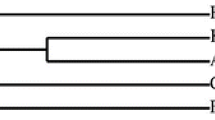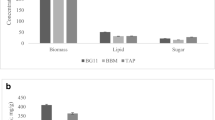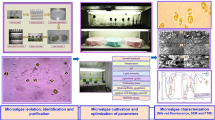Abstract
In this study, effects of different abiotic factors were studied on biomass and lipid yield of green microalga Chlorella minutissima (C. minutissima) Various concentrations of abiotic factors like nitrogen, phosphorus, glucose, iron, zinc, different values of pH, temperature, light intensity and different photoperiods were observed on the biomass growth and lipid yield of C. minutissima cultivated with modified CHU-13 medium. Initially, three cultivation media namely, Bold’s basal medium (BBM), modified CHU-13 and blue-green-11 (BG-11) were used to culture C. minutissima in batch mode. Microalga cultivated with modified CHU-13 medium resulted in maximum biomass and lipid yield of 970 ± 0.21 and 356.63 ± 0.51 mg/L, respectively. To maximize biomass and lipid yield of microalga further, it was cultivated with modified CHU-13 medium and variation of above mentioned abiotic factors was done. Different biomass and lipid yields were achieved for different abiotic factors varied. Highest biomass of 1840.49 ± 0.62 mg/L was achieved with 12 g of glucose containing medium and highest lipid yield of 579.86 ± 0.76 mg/L was achieved with 0.3 g of nitrogen containing medium. GC-MS analysis of biodiesel obtained from C. minutissima biomass cultivated with modified CHU-13 medium shown the presence of C14:0, C16:0, C16:1, C18:0, C18:1, C18:2, C18:3, C20:0, C20:1 and C22:0. Properties of biodiesel obtained from C. minutissima were found in compliance with ASTM-6751-02 and European biodiesel standards EN14214. These results suggest that C. minutissima can be used as a potential biodiesel feedstock for microalgal biodiesel production.













Similar content being viewed by others
References
Abomohra AEF, El-Sheekh M, Hanelt D (2017) Screening of marine microalgae isolated from the hypersaline Bardawil lagoon for biodiesel feedstock. Renew Energy 101:1266–1272
Amit, Rajesh Chandra, Uttam Kumar Ghosh, Jagdeep Kumar Nayak, (2017) Phycoremediation potential of marine microalga Tetraselmis indica on secondary treated domestic sewage for nutrient removal and biodiesel production. Environ Sci Pollut Res 24(26):20868–20875
Borowitzka MA (1999) Commercial production of microalgae: ponds, tanks, tubes and fermenters. J Biotechnol 70:313–321
Cheirsilp B, Torpee S (2012) Enhanced growth and lipid production of microalgae under mixotrophic culture condition: effect of light intensity, glucose concentration and fed-batch cultivation. Bioresour Technol 110:510–516
Chisti Y (2007a) Biodiesel from microalgae. Biotechnol Adv 25:294–306
Chisti Y (2007b) Biodiesel form microalgae beats bioethanol. Trends Biotechnol 26:126–131
Cho HU, Kim YM, Choi YN, Xu X, Shin DY, Park JM (2015) Effects of pH control and concentration on microbial oil production from Chlorella vulgaris cultivated in the effluent of a low-cost organic waste fermentation system producing volatile fatty acids. Bioresour Technol 184:245–250
D’Oca MGM, Viêgas CV, Lemoes JS, Miyasaki EK, Morón-Villarreyes JA, Primel EG, Abreu PC (2011) Production of FAMEs from several microalgal lipidic extracts and direct transesterification of the Chlorella pyrenoidosa. Biomass Bioenergy 35(4):1533–1538
Dumrattana P, Tansakul P (2006) Effect of photoperiod on growth and hydrocarbon content of Botryococcus braunii cultured in effluent from seafood processing plant. Songklanakarin J Sci Technol 28(1):99–105
Folch J, Lees M, Sloane-Stanley GH (1957) A simple method for the isolation and purification of total lipids from animal tissues. J Biol Chem 226(1):497–509
Francisco EC, Neves DB, Jacob-Lopes E, Franco TT (2010) Microalgae as feedstock for biodiesel production: carbon dioxide sequestration, lipid production and biofuel quality. Journal of Chemical Technology and Biotechnology 85(3):395–403
Garcia MCC, Mirón AS, Sevilla JMF, Grima EM, Camacho FG (2005) Mixotrophic growth of the microalga Phaeodactylum tricornutum influence of different nitrogen and organic carbon sources on productivity and biomass composition. Process Biochem 40:297–305. https://doi.org/10.1016/j.procbio.2004.01.016
Gouveia L, Oliveira AC (2009) Microalgae as a raw material for biofuels production. J Ind Microbiol Biotechnol 36(2):269–274
Griffiths MJ, Harrison ST (2009) Lipid productivity as a key characteristic for choosing algal species for biodiesel production. J Appl Phycol 21(5):493–507
Härtig C (2008) Rapid identification of fatty acid methyl esters using a multidimensional gas chromatography–mass spectrometry database. J Chromatogr A 1177(1):159–169
Healey FP (1982) Phosphate Biol Cyanobacteria 19:105–124
Hu Q (2004) Environmental effects on cell composition. In: Richmond A (ed) Handbook of microalgal culture: biotechnology and applied phycology. Blackwell, Oxford, UK, pp 83–93
Ji Y, Hu W, Li X, Ma G, Song M, Pei H (2014) Mixotrophic growth and biochemical analysis of Chlorella vulgaris cultivated with diluted monosodium glutamate wastewater. Bioresour Technol 152:471–476
Knothe G (2012) Fuel properties of highly polyunsaturated fatty acid methyl esters. Prediction of fuel properties of algal biodiesel. Energy Fuel 26(8):5265–5273
Kojima E, Zhang K (1999) Growth and hydrocarbon production by microalga Botryococcus braunii in bubble column photobioreactor. J Biosci Bioeng 87:811–817
Liu ZY, Wang GC, Zhou BC (2008) Effect of iron on growth and lipid accumulation in Chlorella vulgaris. Bioresour Technol 99:4717–4722
Mahamuni NN, Adewuyi YG (2009) Fourier transform infrared spectroscopy (FTIR) method to monitor soy biodiesel and soybean oil in transesterification reactions, petrodiesel-biodiesel blends, and blend adulteration with soy oil. Energy Fuels 23:3773–3782. https://doi.org/10.1021/ef900130m
Mandotra SK, Kumar P, Suseela MR, Ramteke PW (2014) Fresh water green microalga Scenedesmus abundans: a potential feedstock for high quality biodiesel production. Bioresour Technol 156:42–47
Matos ÂP et al (2017) Effects of different photoperiod and trophic conditions on biomass, protein and lipid production by the marine alga Nannochloropsis gaditana at optimal concentration of desalination concentrate. Bioresour Technol 224:490–497
Miao X, Wu Q (2006) Biodiesel production from heterotrophic microalgal oil. Bioresour Technol 97(6):841–846
Minowa T, Yokoyama SY, Kishimoto M, Okakurat T (1995) Oil production from algal cells of Dunaliella tertiolecta by direct thermochemical liquefaction. Fuel 74:1735–1738
Oh SH, Han JG, Kim Y, Ha JH, Kim SS, Jeong MH, Jeong HS, Kim NY, Cho JS, Yoon WB, Lee SY, Kang DH, Lee HY (2009) Lipid production in Porphyridium cruentum grown under different culture conditions. J Biosci Bioeng 108:429–434
Pandit PR, Fulekar MH, Karuna MSL (2017) Effect of salinity stress on growth, lipid productivity, fatty acid composition, and biodiesel properties in Acutodesmus obliquus and Chlorella vulgaris. Environ Sci Pollut Res 24:13437–13451
Patel AK, Singhania RR, Pandey A (2014) Biofuels from biomass. In: Agarwal A, Pandey A, Gupta A, Aggarwal S, Kushari A (eds) Novel combustion concepts for sustainable energy development. Springer, New Delhi
Patel A, Sindhu DK, Arora N, Singh RP, Pruthi V, Pruthi PA (2015) Biodiesel production from non-edible lignocellulosic biomass of Cassia fistula L. fruit pulp using oleaginous yeast Rhodosporidium kratochvilovae HIMPA1. Bioresour Technol 197:91–98
Pereira HM, Ferrier S, Walters M, Geller GN, Jongman RHG, Scholes RJ, Bruford MW, Brummitt N, Butchart SHM, Cardoso AC, Coops NC, Dulloo E, Faith DP, Freyhof J, Gregory RD, Heip C, Hoft R, Hurtt G, Jetz W, Karp DS, McGeoch MA, Obura D, Onoda Y, Pettorelli N, Reyers B, Sayre R, Scharlemann JPW, Stuart SN, Turak E, Walpole M, Wegmann M (2013) Essential biodiversity variables. Science 339 (6117):277–278
Perlack RD, Wright LL, Turhollow AF, Graham RL, Stokes BJ, Erbach DC (2005) Biomass as feedstock for a bioenergy and bioproducts industry: the technical feasibility of a billion-ton annual supply. In: Technical report. Oak Ridge National Laboratory (ORNL), Oak Ridge, TN, USA
Predojević Z, Škrbić B, Đurišić-Mladenović N (2012) Transesterification of linoleic and oleic sunflower oils to biodiesel using CaO as a solid base catalyst. J Serb Chem Soc 77(6):815–832
Ruangsomboon S (2012) Effect of light, nutrient, cultivation time and salinity on lipid production of newly isolated strain of the green microalga, Botryococcus braunii KMITL 2. Bioresour Technol 109:261–265. https://doi.org/10.1016/j.biortech.2011.07.025
Searchinger T, Edwards R, Mulligan D, Heimlich R, Plevin R (2015) Do biofuel policies seek to cut emissions by cutting food? Science 347:1420–1422
Shrotri C, Rathore V, Mohanty P (1981) Studies on photosynthetic electron transport, photophosphorylation and CO2 fixation in Zn2+ deficient leaf cells of Zea mays. J Plant Nutri 3:945–954
Smith VH, Sturm BS, Denoyelles FJ, Billings SA (2009) The ecology of algal biodiesel production. Trends Ecol Evol 25:301–309
Sushchik NN, Kalacheva GS, Zhila NO, Gladyshev MI, Volova TG (2003) A temperature dependence of the intra- and extracellular fatty-acid composition of green algae and cyanobacterium. Russian Journal of Plant Physiology: a Comprehensive Russian Journal on Modern Phytophysiology 50(3):374–380. https://doi.org/10.1023/A:1023830405898
Travieso L, Cañizares RO, Borja R, Benítez F, Domínguez AR, Dupeyrón R, Valiente V (1999) Heavy metal removal by microalgae. Bull Environ Contam Toxicol 62(2):144–151
Wang C, Li H, Wang Q, Wei P (2010) Effect of pH on growth and lipid content of Chlorella vulgaris cultured in biogas slurry. Sheng Wu Gong Cheng Xue Bao 26:1074–1079
Weissman JC, Goebel R (1987) Microalgal open pond systems for the purpose of producing fuels. A subcontract report, pp. 1–231
Yeesang C, Cheirsilp B (2011) Effect of nitrogen, salt, and iron content in the growth medium and light intensity on lipid production by microalgae isolated from freshwater sources in Thailand. Bioresour Technol 102(3):3034–3040
Acknowledgements
The first and corresponding author is thankful to the Ministry of Human Resource Development (MHRD), Government of India, India, for providing financial support and Department of Polymer and Process Engineering, Indian Institute of Technology Roorkee (Saharanpur Campus) to accomplish this research work.
Author information
Authors and Affiliations
Corresponding author
Additional information
Responsible editor: Philippe Garrigues
Highlights
• Initially modified CHU-13 medium produced highest biomass and lipid yield in C. minutissima.
• Highest biomass and lipid yields of 1840.49 ± 0.62 and 579.86 ± 0.76 mg/L were achieved with 12 g of glucose and 3 g of nitrogen containing CHU-13 medium.
• Cultivation temperature of 27 ± 2 °C and pH 8 were found optimal for higher biomass yield.
• Zinc concentration beyond 100 mg/L resulted in reduced biomass growth.
• Biodiesel quality was found in compliance with international fuel standards.
Rights and permissions
About this article
Cite this article
Chandra, R., Amit & Ghosh, U.K. Effects of various abiotic factors on biomass growth and lipid yield of Chlorella minutissima for sustainable biodiesel production. Environ Sci Pollut Res 26, 3848–3861 (2019). https://doi.org/10.1007/s11356-018-3696-1
Received:
Accepted:
Published:
Issue Date:
DOI: https://doi.org/10.1007/s11356-018-3696-1




